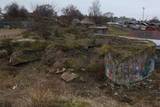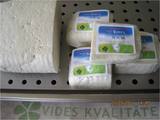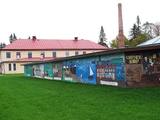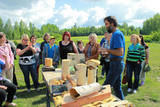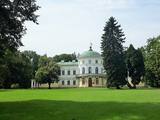| Nr | Nosaukums | Apraksts |
|---|---|---|
|
Bolderājā – austrumos no Lielupes ielas un dienvidaustrumos no Jātnieku ielas Daugavas krastā ir saglabājušās paliekas no četrām uzspridzinātām batereju pozīcijām. Šīs baterejas, kurās atradās 152. kalibra lielgabali, ir daļa no kādreizējās Rīgas fortifikāciju sistēmas (sk. arī Komētfortu, Daugavgrīvas cietoksni, Mangaļsalas fortifikācijas), kuras mērķis bija aizsargāt pilsētu no uzbrucējiem, kas nāktu (nāca) no jūras puses. No batereju augšas labi redzama Daugava un no jauna uzbērtā Krievu salas ziemeļdaļa (milzīgs smilšu kalns). Šī vēstures pieminekļa un tās apkārtnes stāvoklis – vairāk kā bēdīgs ...
|
||
|
Piedāvā ekskursiju pa saimniecību ar kazu, zirgu, trušu, putnu un mājdzīvnieku apskati. Interesenti var pieteikties uz reiterapijas seansiem, vizināties zirgā, uz ponija un pajūgā. Kazkopības produkcijas – piena, siera, biezpiena, kefīra un jogurta iegāde. |
||
|
Līdz akmenim aizved (ir norādes) skaista taka, kas līkumo pa Rogāļu strauta izrauto gravu. Strauta kreisā krasta nogāzē, ~ 0,1 km pirms tā ietekas Daugavā, iegūlis 6,5 m garais, 4,6 m platais un līdz 3,7 m augstais Rogāļu akmens, kura tilpums ir novērtēts ap 40 m³. Blakus tam atrodas liela atlūza. |
||
|
Rožu laukuma pirmsākumi meklējami 1911. - 1913. gadā, kad šajā vietā izveidoja atklātu dārzu ar > 500 rožu krūmiem. Padomju laikos Rožu laukumam blakus esošajā laukumā bija novietots Ļeņina piemineklis. 2000. g. atjaunoto laukumu ieskauj Liepājas Pedagoģijas akadēmija, viesnīca “Līva”, biznesa un darījumu centrs „De Rome” (celta 19. gs., arhitekts Pauls Makss Berči, bijusī Romas viesnīca) un Liepājas Latviešu biedrības nams (1934., pamatakmeni licis Kārlis Ulmanis). Uz rožu dobes apmales ir izvietotas Liepājas sadraudzības pilsētu piemiņas zīmes. Rožu laukumam piekļaujas Zivju iela, kas nosaukumu ieguvusi no kādreizējā zivju tirgus. Zivju ielā meklējama Latvijas mūziķu Slavas aleja (no 2006. g.), kurā izvietoti 35 mūziķu plaukstu atlējumi bronzā, apskatāmas 10 plāksnes, kas veltītas populārām Latvijas mūzikas grupām, bet piecas - nu jau aizsaulē aizgājušajiem. Turpat novietota Latvijas lielākā ģitāra. |
||
|
Atrodas Gudenieku ciema dienviddaļā. Tagad redzamais dievnams celts laikā no 1930. – 1947. g. Tās interjerā atrodas baznīcas altāris, kura sastāvdaļa ir 17. – 18. gs. mijā tapušie Subates meistaru rotājumi – eņģeļu skulptūras (vienīgie tādi Kurzemes baznīcu baroka dekoratīvajā tēlniecībā), kas piestiprinātas pie ēkas sienām abpus altārim. Iespējams, ka arī Pestītāja figūra uz krusta ar guļošo jēru pie kājām ir minēto meistaru darinājums. No kurienes un kā baznīca ieguvusi Subates meistaru darbus – nav zināms. Ērģeles ar koka stabulēm darinājis Juri Bokums. Sezonas laikā baznīca apskatāma arī no iekšpuses. |
||
|
19. gadsimta otrajā pusē Igaunijā sākās nopietna piensaimniecības attīstība.Lai saglabātu atmiņas par šo laiku un nodotu tās tālāk nākamajām paaudzēm, 1976. gadā tika nodibināts Igaunijas Piensaimniecības muzejs. Muzeja izstādījumi iedalās divās daļās – pastāvīgā ekspozīcijā un izstādēs. Populāras ir muzeja programmas. Grupas var pasūtīt arī gida pakalpojumu. |
||
|
Atrodas austrumos no Tirgus laukuma, Baznīcas ielā 8. Tās telpās entuziasti cenšas atjaunot un uzturēt senās amatu tradīcijas. Amatu prasmju darbnīcas šeit tiek organizētas piecas dienas nedēļā. |
||
|
Tāšu meistars Jurijs Ivanovs ar lielu centību un degsmi pēc seniem paraugiem cenšas atjaunot labākās Zilupes novada tāšu apstrādes tradīcijas. Top novadam raksturīgi autentiski tāšu trauki ķiploku, putraimu, saldumu, sāls uzglabāšanai, paliktnīši kafijas krūzei vai pannai. Īsts meistarstiķis ir darbarīku rokturu izgatavošana. Darbnīcā varēsiet izgatavot tāšu glezniņu, tāšu tauri, uzrakstīt īpašu vēstuli kādam ļoti mīļam cilvēkam. |
||
|
Jaunciems atradies pāris kilometru no Irbes grīvas uz Kolkas pusi. Senos laikos ar Lielirbi beigušies Popes barona īpašumi, bet ar Jaunciemu sākusies Dundagas barona teritorija. Jauciems jau agrāk bijis neliels ciems, bet šodien rosība manāma vairs tikai dažās mājās. Jaunciema pusē Irbes upes labajā krastā plašā posmā pie ietekas jūrā a/s „Latvijas valsts meži” ierīkojuši pievilcīgas atpūtas vietas. Pie ietekas jūrā Irbe veido 2 km garu smilšu strēli, bet pati ieteka katru gadu maina savu vietu un izskatu. Starp Jaunciemu un upi atrodas arī 24 m augsta kāpa - Baltais kalns. Jaunciemu ar Sīkragu savieno bijušā mazbānīša „stiga”, kur pāri Ķikanam izveidots gājēju un velosipēdistu tiltiņš. |
||
|
Daugavas kanjons no Pļaviņām līdz Koknesei pirms appludināšanas bija viena no izcilākajām un skaistākajām Baltijas reljefa formām, bet Oliņkalns - viens no Latvijas lielākajiem pilskalniem, kura līdz 20 m augstā klints (Andreja klints) bija Daugavas kanjona sastāvdaļa. Pie Oliņkalna Daugavā pirms appludināšanas bija stipra krāce, kas apgrūtināja plostnieku darbu. Mūsdienās Oliņkalns ir neliela sala Pļaviņu HES ūdenskrātuvē (zinātājs pamanīs no Rīgas – Daugavpils šosejas (A 6) iepretim Stukmaņiem), ko no krasta atdala 0,3 km plata upes atteka, zem kuras dzelmē dus Dūņu leja. Uz salas saglabājies neliels pilskalna valnis, estrādes paliekas un dažus metrus augsts dolomīta atsegums – Andreja klints paliekas. Uzskata, ka Oliņkalnā 13. gs. atradusies Alenes pils. Pie Daugavas iepretim Oliņkalnam ir piemiņas akmens, ko 1989. g. uzstādīja Latvijas alpīnisti. |
||
|
Atrodas Valmieras – Ainažu autoceļa (P 16) malā starp Matīšiem un Aloju. Iekārtota vecajā un atjaunotajā dzirnavu ēkā. Nedēļas nogalēs piedāvā izklaides pasākumus, klāj galdus un īrē telpas svinībām. |
||
|
Saimniecība atrodas 4 km ziemeļrietumos no Sunākstes, - vietā, kur savulaik atradies šaursliežu dzelzceļš. Tagadējā dzīvojamā māja – „Bānīši” ir bijusī šaursliežu dzelzceļa stacijas ēka. Apkaimes laukos 3 h platībā tiek audzētas upenes, kuras apmeklētāji var paši novākt savām vajadzībām, kā arī garšaugi, dārzeņi un augļkoki. Dārzā pacelts saimnieku dzimtas karogs. Nelielām interesentu grupām piedāvā pirti, stāsta par apkaimes vēsturiskajiem notikumiem. |
||
|
Līdz 13. gs. Smiltenes novads ietilpa latgaļu apdzīvotajā Tālavas zemē. Pēc krustnešu invāzijas to ieguva Rīgas arhibīskaps, stāvajā Abula upes krastā 1370. g. uzceļot mūra pili. Sekojoši kari un epidēmijas nesaudzēja ne apdzīvotās vietas apbūvi, ne arī iedzīvotājus. Tagadējās pilsētas aprises sāka rasties 19. gs. beigās līdz ar Smiltenes muižas īpašnieka firsta Līvena aktīvo darbību. Līdz 1. pasaules karam Smiltenē darbojās kokapstrādes fabrika, hidroelektrostacija (1901. g., pirmā Baltijā) u.c. uzņēmumi. 1944. g. vācu karaspēkam atkāpjoties, ugunsgrēka laikā aizgāja bojā liela daļa Smiltenes vēsturiskās apbūves. |
||
|
Daugavas aizsargdambju būvniecību Jēkabpilī uzsāka pēc 1981. gada lielajiem paliem, kad ūdens līmenis pārsniedza kritisko - 6,3 m atzīmi un pakāpās līdz rādījumam „8,7 metri”. Šo plūdu laikā puse pilsētas klāja Daugavas ūdeņi. 2011. gada vasarā notika plašāki dambja atjaunošanas un labiekārtošanas darbi. Pie tā uzstādīja laternas, soliņus, izveidoja pastaigu promenādi un piemiņas zīmi Daugavas kreisajā krastā, kas parāda maksimālo plūdu līmeni. Uz aizsargdambja Daugavas labajā krastā ir izvietoti informatīvie stendi, kur var uzzināt daudz interesantus faktus par pilsētas vēsturi. Dambji ir piemērota vieta, kur fotografēt vai gleznot pilsētas ainavas. |
||
|
Atraktīvais amatnieks ir viens no "Pūdnīku skūlas" podniekiem, kas izmanto senču uzkrātās zināšanas. Darbnīcā "Malny Wylky" var redzēt tradicionālo darbu tapšanas procesu no virpošanas ar kājminamo virpu līdz to apdedzināšanas bedres tipa malkas ceplī svēpējuma tehnikā. Darbu apskate un iegāde. Vēsma Ušpele savukārt glezno eļļas tehnikā un parādīs savus darbus. |
||
|
Pirts Juglas upes krastā atpūtai ģimenēm (nav paredzēts skaļiem pasākumiem). Maksimālais personu skaits - 6 personas. Pieejamas dažādas aktivitātes vecākiem ( krievu pirts, dīķī makšķerēšana, jaunākie preses izdevumi ) un bērniem ( rotaļas, batuts, novuss, velosipēdi, trusīšu barošana). Pirts svaigi izremontēta, labiekārtota, var pasūtīt vakariņas, brokastis. Atrodas 25 km no Rīgas, var braukt ar autobusu. Cena atkarīga no izmantotā pakalpojuma un personu skaita.
|
||
|
Baisogalos muiža ir viena no senākajām muižām – saukta karaliskā, jo piederēja Lietuvas lielajam kunigaitim. Līdz mūsdienām saglabājušies greznie, vēlīnā klasicima stila (ampīra) muižas nami celti 19.gs. vidū. 12 ha ainaviskais Baisogalos parks izveidots 19.gs. pirmajā pusē. No ciemata puses uz muižu ved kastaņu aleja. No vārtiem centrālā aleja ved caur diviem līkumotām ūdens krātuvēm, pār tiltiņu ar lauvu figūrām. Aiz muižas dažādi koki aptver līkumotās alejas un šaurus parka celiņus. Abu parka aleju pusēs atrodas pa ūdens krātuvei, parka dziļumā – dīķis ar salu. |
||
|
Dole ir lielākā no Daugavas salām. No ZA to ieskauj straujie Daugavas, bet no DR - mierīgie un pamazām aizaugošie Sausās Daugavas ūdeņi. Salai piešķirts dabas parka (īpaši aizsargājama dabas teritorija) statuss. Tas dibināts 1987. g. ar mērķi saglabāt pēc Rīgas HES celtniecības atlikušās Doles salas ainavu un kultūrvēsturiskās vērtības, kā arī retas un aizsargājamas augu un dzīvnieku sugas. Vēl viens parka izveides mērķis – veicināt sabiedrības izziņu un atpūtu. Viens no zināmākajiem Doles salas apskates objektiem ir Daugavas muzejs, kas iekārtots Doles muižas dzīvojamā ēkā. Muzeja krājumā atrodas ~ 13 000 dažādu eksponātu, - Doles salas un Daugavas krastu vēstures liecinieki - baltu un lībiešu apģērbi, darbarīki, sadzīves priekšmeti. Ekspozīcija iepazīstina ar Daugavas kā nozīmīga ūdensceļa un ar to saistīto transporta līdzekļu un plostnieku vēsturi. Doles muižas parkā izvietota muzeja brīvdabas ekspozīcija ar nēģu taču un lašu zvejas aizsprosta rekonstrukciju un zvejas rīku kolekcija. Pie muzeja stāvajā Sausās Daugavas krastā atrodas dolomīta atsegums. Salas DA daļā Daugavas krastā pie Bēčiem apskatāmas Vecdoles pilsdrupas. |
||
|
„Strauti” atrodas Embūtes pauguraines austrumu malā. No dienvidiem tos ieskauj plaši mežu masīvi, kuros mīt daudzi Latvijas savvaļā sastopamie dzīvnieki. Blakus saimniecībai atrodas bijušās putnu fermas korpusi. Saimniecībā audzē vaislas trušus, aitas, dažādu šķirņu mājputnus, divus zirgus un poniju. Saimniecības laukos ganās govju ganāmpulks, kurā starp dažādu šķirņu govīm apskatāmas arī Latvijas Zilās govis. Saimniece piedāvā ekskursijas skolēnu grupām un citiem interesentiem. Iepriekš vienojoties, iespējama trušu gaļas, aitas vilnas, kā arī saimniecībā izaudzēto dārzeņu iegāde. Bioloģiskā saimniecība. |
||
|
Pakri pussalas galā slejas vizuāli iespaidīgākā no Baltijas valstu piekrastes klintīm - līdz 24 m augstā Pakri klints (Pakri pank). Aukstās ziemās no kaļķakmens slāņiem izplūstošie avoti veido fantastiskus leduskritumus un neparastas ledus formas.
|
||
